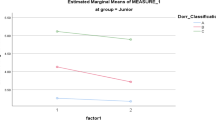Abstract
Background
Initial fixation is a key factor in the success of cementless THA using a tapered wedge stem. The purpose of this study was to use three-dimensional templating software to examine the correlation between quantitative contact state and important clinical radiological outcomes, specifically stem subsidence, stress shielding, and cortical hypertrophy.
Methods
We conducted a retrospective consecutive review of 75 hips in 70 patients over a minimum 3-year follow-up period. X-rays and CT scans were investigated to assess preoperative planning, quantify the contact state of implant and femur, and assess stem alignment, stem subsidence, stress shielding, and cortical hypertrophy. We evaluated the correlation between radiological outcomes and three-dimensional quantitative contact state according to Gruen Zone in each Dorr classification.
Results
Density map** indicated that stem subsidence increased postoperatively if the stem had less cortical contact in the middle to distal portion of the implant in terms of initial fixation. Cases having too much cortical contact in the distal portion of the implant tended to have increased stress shielding. We found no correlation between cortical hypertrophy and the contact state of implant and femur.
Conclusions
Density map** with three-dimensional templating software can be useful in predicting stem subsidence and stress shielding following cementless THA with a tapered wedge stem. Further analysis is required to accurately depict the correlation between cortical hypertrophy and the contact state.





Similar content being viewed by others
References
Devane PA, Wraighte PJ, Ong DCG, Horne JG (2012) Do joint registries report true rates of hip dislocation? Clin Orthop Relat Res 470(11):3003–3006
McLaughlin JR, Lee KR (2008) Total hip arthroplasty with an uncemented tapered femoral component. J Bone Joint Surg Am 90(6):1290–1296
Teloken MA, Bissett G, Hozack WJ, Sharkey PF, Rothman RH (2002) Ten to fifteen-year follow-up after total hip arthroplasty with a tapered cobalt-chromium femoral component (tri-lock) inserted without cement. J Bone Joint Surg Am 84-A(12):2140–2144
Purtill JJ, Rothman RH, Hozack WJ, Sharkey PF (2001) Total hip arthroplasty using two different cementless tapered stems. Clin Orthop Relat Res 393:121–127
White CA, Carsen S, Rasuli K, Feibel RJ, Kim PR, Beaulé PE (2012) High incidence of migration with poor initial fixation of the accolade stem. Clin Orthop Relat Res 470(2):410–417
Khanuja HS, Vakil JJ, Goddard MS, Mont MA (2011) Cementless femoral fixation in total hip arthroplasty. J Bone Joint Surg Am 93(5):500–509
Haraguchi K, Sugano N, Nishii T, Koyama T, Nishihara S, Yoshikawa H, Ochi T (2001) Comparison of fit and fill between anatomic stem and straight tapered stem using virtual implantation on the ORTHODOC workstation. Comput Aided Surg 6(5):290–296
Nishihara S, Sugano N, Nishii T, Tanaka H, Yoshikawa H, Ochi A (2003) Comparison of the fit and fill between the Anatomic Hip femoral component and the Versys Taper femoral component using virtual implantation on the ORTHODOC workstation. J Orthop Sci 8(3):352–360
Inoue D, Kabata T, Maeda T, Ka**o Y, Fujita K, Hasegawa K, Yamamoto T, Takagi T, Ohmori T, Tsuchiya H (2015) Usefullness of three-dimensional templating software to quantify the contact state between implant and femur in total hip arthroplasty. Eur J Orthop Surg Traumatol 25(8):1293–1300
Crowe JF, Mani VJ, Ranawat CS (1979) Total hip replacement in congenital dislocation and dysplasia of the hip. J Bone Joint Surg Am 61(1):15–23
Dorr LD, Faugere MC, Mackel AM, Gruen TA, Bognar B, Malluche HH (1993) Structural and cellular assessment of bone quality of proximal femur. Bone 14(3):231–242
Engh CA, Bobyn JD, Glassman AH, Porous-coated hip replacement (1987) The factors governing bone ingrowth, stress shielding, and clinical results. J Bone Joint Surg Br 69(1):45–55
Ritter MA, Fechtman RW (1988) Distal cortical hypertrophy following total hip arthroplasty. J Arthroplast 3(2):117–121
Ka**o Y, Kabata T, Maeda T, Iwai S, Kuroda K, Fujita K, Tsuchiya H (2013) Strict component positioning is necessary in hip resurfacing. J Orthop Sci 18(2):290–297
Hounsfield GN (1980) Computed medical imaging. Science 210(4465):22–28
Gruen TA, McNeice GM, Amstutz HC (1979) “Modes of failure” of cemented stem-type femoral components: a radiographic analysis of loosening. Clin Orthop Relat Res 141:17–27
Laine HJ, Pajamaki KJ, Moilanen T, Lehto MU (2001) The femoral canal fill of two different cementless stem designs. The accuracy of radiographs compared to computed tomographic scanning. Int Orthop 25(4):209–213
Issa K, Stroh AD, Mont MA, Bonutti PM (2014) Effect of bone type on clinical and radiographic outcomes of a proximally-coated cementless stem in primary total hip arthroplasties. J Orthop Res 32(9):1214–1220
van der Wal BC, de Kramer BJ, Grimm B, Vencken W, Heyligers IC, Tonino AJ (2008) Femoral fit in ABG-II hip stems, influence on clinical outcome and bone remodeling: a radiographic study. Arch Orthop Trauma Surg 128(10):1065–1072
Inoue D, Kabata T, Maeda T, Ka**o Y, Fujita K, Hasegawa K, Yamamoto T, Tsuchiya H (2015) Value of computed tomography-based three-dimensional surgical preoperative planning software in total hip arthroplasty with developmental dysplasia of the hip. J Orthop Sci 20(2):340–346
Sariali E, Mouttet A, Pasquier G, Durante E, Catone Y (2009) Accuracy of reconstruction of the hip using computerized three dimensional pre-operative planning and a cementless modular neck. J Bone Joint Surg Br 91(3):333–340
Hassani H, Cherix S, Ek ET, Rüdiger HA (2014) Comparisons of preoperative three-dimensional planning and surgical reconstruction in primary cementless total hip arthroplasty. J Arthroplast 29(6):1273–1277
Jacobs CA, Christensen CP (2009) Progressive subsidence of a tapered, proximally coated femoral stem in total hip arthroplasty. Int Orthop 33(4):917–922
Cooper HJ, Jacob AP, Rodriguez JA (2011) Distal fixation of proximally coated tapered stems may predispose to a failure of osteointegration. J Arthroplast 26(6 Suppl):78–83
Huppertz A, Radmer S, Asbach P, Juran R, Schwenke C, Diederichs G, Hamm B, Sparmann M (2011) Computed tomography for preoperative planning in minimal invasive total hip arthroplasty: radiation and cost analysis. Eur J Radiol 78(3):406–413
Author information
Authors and Affiliations
Corresponding author
Ethics declarations
Conflict of interest
The authors did not receive any benefits or findings from any commercial party related directly or indirectly to the subjects of this article.
Ethical approval
All procedures performed in studies were in accordance with the ethical standards of our institutional ethical committee. In accordance with the requirements of this study, all patients provided informed consent.
Rights and permissions
About this article
Cite this article
Inoue, D., Kabata, T., Maeda, T. et al. The correlation between clinical radiological outcome and contact state of implant and femur using three-dimensional templating software in cementless total hip arthroplasty. Eur J Orthop Surg Traumatol 26, 591–598 (2016). https://doi.org/10.1007/s00590-016-1796-5
Received:
Accepted:
Published:
Issue Date:
DOI: https://doi.org/10.1007/s00590-016-1796-5




